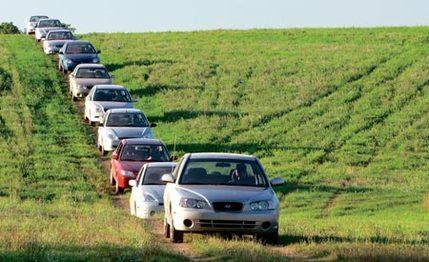
 Comparison Tests
Comparison Tests
As they say down in the squint print of those mutual-fund ads, past performance is no guarantee of future results.
What if the economy doesn't roar ahead in the '00s as it did in the '90s? What if cheap gas is just a memory? What if the GDP stumbles into the dreaded double dip and car shopping is guided by — groan — "new realities"?
May we show you something in a frugal car? No, no, we're talking affordable cars here, not cheap ones.
The casting call said, "Wanted: Cars for the role of all-around four-door. Anti-lock brakes and side airbags a plus. Only five-speed manuals need apply. About $16,000."
Ten hopefuls showed up along with two envelopes bearing regrets, the latter from divisions of GM. The new Saturn Ion was in the pipeline for an autumn debut, but no sample was available by summer's end. A few Chevy Cavaliers were up and running following a heavy makeover for the new model year, but none was available with a manual transmission.
Answering the call were two Americans, two Koreans, and six Japanese. The Ford Focus, three-time honoree on our 10Best Cars list, has to be the heavy in this group. In four-door form, it packs an impressive amount of useful space into a good-looking designer box.
The Dodge Neon is the other home-team player. What a cutie it was in its younger days, and what a winner it is now in PT Cruiser clothes. As a four-door sedan, though, it has yet to prove itself.
The Hyundai Elantra and the Kia Spectra are products of the same Korean industrial giant, Hyundai Motor Company. Yet they share few major components apart from a towering warranty — 10 years/100,000 miles on the powertrain, 5 years/60,000 miles on the rest of the car. In the small-car world, these are the price leaders, following in the path of Japanese makers who relied on low prices to push into the U.S. in the '70s. And we think it's only a matter of time until Korean cars gain the quality and sophistication necessary to compete on merit. Are they there yet? We'll know by the end of this test.
The Japanese, of course, sit still for no one. Honda introduced its seventh generation of the famously satisfying Civic in 2001, a car that's lighter and more efficient than ever before. Still, that was two years ago. In the game of new-model leapfrog, Toyota's all-new Corolla for 2003 represents fresher technology. For that reason alone, Las Vegas oddsmakers would surely nod toward Toyota if we asked them. But we testers don't consult with conjurers. We have test tracks and measuring equipment linked up with satellites and, to fill in the subtle details, the seats of our calibrated trousers. Going in, Toyota versus Honda is too close to call.
What could surprise? Probably not the tall-boy Suzuki Aerio. It, too, is new for 2003, but Suzuki has chosen a quirky approach that pretty much ensures it will be a memorable character actor rather than an Oscar winner.
Mitsubishi's new-for-oh-two Lancer is another character blessed with neither a pretty face nor a muscular engine. If you were touting this one for a blind date, you'd promise, "So easy to talk to." We'll see.
We'll see, too, about Nissan's veteran Sentra. The reinvigorated company is drawing kudos for its newest models, both sedan and sporty, but the Sentra hangs in there from the days when Nissan was trailing smoke and losing altitude.
If birth dates set the pecking order, we'd have similarly low expectations for Mazda's 1999-intro Protegé. But this car has always been an overachiever. It copped the top spot in our last econocar comparison ("Little Cars 6.1," June 2000) for a reason that usually proves enduring — it's really a kick to drive.
Could an aging sporty sedan hold its place against the inexorably rising tide of technology? Let's hit the road and find out.